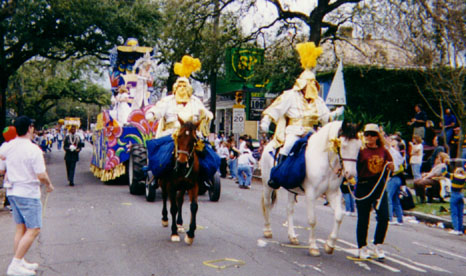About
About Mordi Gras New Orleans

The holiday of Mardi Gras is celebrated in all of Louisiana, including the city of New Orleans. Celebrations are concentrated for about two weeks before and through Shrove Tuesday, the day before Ash Wednesday (the start of lent in the Western Christian tradition). Usually there is one major parade each day (weather permitting); many days have several large parades. The largest and most elaborate parades take place the last five days of the Mardi Gras season. In the final week, many events occur throughout New Orleans and surrounding communities, including parades and balls (some of them masquerade balls).
The parades in New Orleans are organized by social clubs known as krewes; most follow the same parade schedule and route each year. The earliest-established krewes were the Mistick Krewe of Comus, the earliest, Rex, the Knights of Momus and the Krewe of Proteus. Several modern "super krewes" are well known for holding large parades and events, such as the Krewe of Endymion (which is best known for naming celebrities as grand marshals for their parades), the Krewe of Bacchus (similarly known for naming celebrities as their Kings), as well as the Zulu Social Aid & Pleasure Club—a predominantly African American krewe. Float riders traditionally toss throws into the crowds. The most common throws are strings of colorful plastic beads, doubloons, decorated plastic "throw cups", Moon Pies, and small inexpensive toys. Major krewes follow the same parade schedule and route each year.
many tourists center their Carnival season activities on Bourbon Street, major parades originate in the Uptown and Mid-City districts and follow a route along St. Charles Avenue and Canal Street, on the upriver side of the French Quarter. Walking parades - most notably the Krewe du Vieux and Chewbacchus - also take place downtown in the Faubourg Marigny and French Quarter in the weekends preceding Mardi Gras day. Mardi Gras day traditionally concludes with the "Meeting of the Courts" between Rex and Comus.
a member of the court requires much preparation, usually months ahead. Women and girls must have dress fittings as early as the May before the parade, as the season of social balls allows little time between each parade. These balls are generally by invitation only. Balls are held at a variety of venues in the city, large and small, depending on the size and budget of the organization. In the late 19th and early 20th century, the French Opera House was a leading venue for New Orleans balls. From the mid 20th century until Hurricane Katrina the Municipal Auditorim was the city's most famous site for Carnival balls. In more recent years, most are at the ballrooms of various hotels throughout the city. The largest "Super Krewes" use larger venues; Bacchus the Morial Convention Center and Endymion the Superdome.
of the most famous and the most sought after throws, is the Zulu Coconut also known as the Golden Nugget and the Mardi Gras Coconut.[6] The coconut is mentioned as far back as 1910, where they were given in a natural "hairy" state. The coconut was thrown as a cheap alternative, especially in 1910 when the bead throws were made of glass. Before the Krewe of Zulu threw coconuts, they threw walnuts that were painted gold. This is where the name "Golden Nugget" originally came from. It is thought that Zulu switched from walnuts to coconuts in the early 1920s when a local painter, Lloyd Lucus, started to paint coconuts. Most of the coconuts have two decorations. The first is painted gold with added glitter, and the second is painted like the famous black Zulu faces. In 1988, the city forbade Zulu from throwing coconuts due to the risk of injury; they are now handed to onlookers rather than thrown. In the year 2000, a local electronics engineer, Willie Clark, introduced an upgraded version of the classic, naming them Mardi Gras Coconuts. These new coconuts were first used by the club in 2002, giving the souvenirs to royalty and city notables.
New Orleans Mayor
LaToya Cantrell

LaToya Cantrell (born April 3, 1972) is an American politician serving as the Mayor of New Orleans, Louisiana, a post she has held since May 7, 2018.
Cantrell, a Democrat, is the first woman to hold the post. Before becoming mayor, Cantrell represented District B on the New Orleans City Council from 2012–2018.